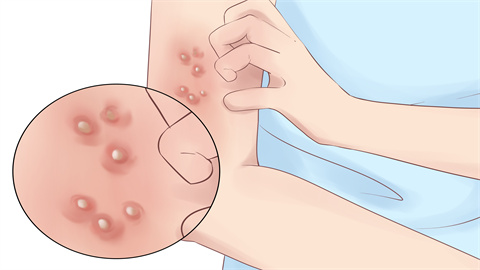What are the symptoms of scabies?
Generally, the typical symptoms of scabies mainly include severe itching at night, specific burrows on the skin, scattered red papules and vesicles, nodules on the male scrotum, and rashes concentrated in thin and tender skin areas. Each symptom has distinct characteristics. The specific analysis is as follows:

1. Severe itching at night: The itching caused by scabies worsens notably at night because the mites become more active. Their burrowing and secretion/excretion processes more intensely stimulate the skin's nerve endings during nighttime.
2. Specific skin burrows: Gray-white or light-black thread-like burrows appear on the skin surface, measuring 0.5-1 cm in length and often curved or irregular in shape. These burrows typically end with a tiny white dot the size of a pinhead. These burrows are commonly found in tender skin areas such as between the fingers and the inner wrists, and are unique to scabies.
3. Scattered red papules and vesicles: Scattered light red or skin-colored small papules appear on the skin, some of which may develop into pinhead-to-millet-sized vesicles. These are usually isolated but may occasionally coalesce. Papules and vesicles are commonly seen in areas such as the armpits, groin, and inner thighs and are easily damaged by scratching, forming superficial eroded surfaces.
4. Nodules on the male scrotum: Male patients often develop hard, smooth, pea-sized, light red or skin-colored nodules on the scrotum or penis. These nodules are firm in texture and accompanied by significant itching. The itching lasts for a prolonged period. Even after symptoms on other parts of the body improve, these nodules may persist for weeks or even months.
5. Rashes concentrated in thin and tender skin areas: Scabies rashes are not distributed throughout the entire body but rather concentrated in thin, tender, and concealed skin regions. In addition to the areas between the fingers, wrists, and armpits, these rashes may also appear in the elbow creases, waist, buttocks, and under the female breasts. Infants, due to their tender skin, may experience rash spread to the palms, soles of the feet, and even the face.
It is recommended that once the above symptoms appear, clothing should be changed promptly and boiled for disinfection or exposed to sunlight. Close contact with others should be avoided to prevent transmission. Additionally, maintaining clean and dry skin and minimizing scratching to prevent skin damage and subsequent infection will help alleviate symptoms and promote recovery.




